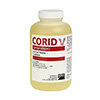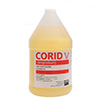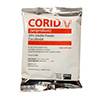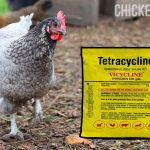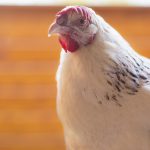Corid for Chickens: Dosage & Treatment of Coccidiosis
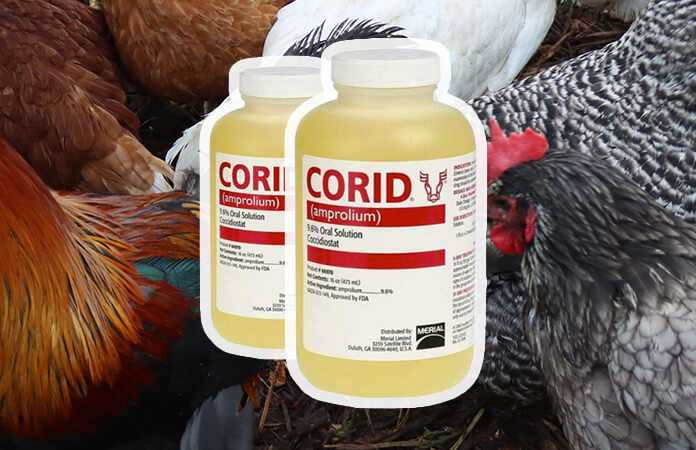

Chicken Fans is reader-supported. When you buy through our links, we may earn a commission. Learn more about our privacy policy and disclaimer.
Corid, also known as the medication Amprolium, is used to treat coccidiosis, a terrible chicken disease. It is considered to be safe, with only a few side effects, and is therefore quite popular with chicken keepers. Let’s learn more about Corid for chickens its correct dosage and use.
| Effective against | Coccidiosis |
| Not effective against | Worms, Bacterial infections |
| Type of medicine | Anti-coccidial |
| Active Ingredient | Amprolium |
| Egg withdrawal period | No withdrawal period (FDA) |
| Meat withdrawal period | 3 days |
| Effective within | Up to 24 hours |
| Dosage Treatment | Water: 120-240 mg/liter; 5-7 days Feed: 125 mg/kg feed; 5-7 days |
| Dosage Prevention | Water: 60mg/liter; 1-2 weeks |
| Side Effects | Lack of appetite, diarrhea Neurological signs (in case of overdose) |
| Similar Brands | AMPROLIUM 20% (PO), Amprol®, AmproMed®, Amprolum 22% powder, PROCOC WDP (combination product) |
We discuss the uses and dosage of Corid for treating coccidiosis in chickens, how it works, and important considerations for its safe use.
What is Corid?
Corid is a common and effective drug for preventing and treating Coccidiosis in chickens and turkeys, a severe parasitic infection. Corid is considered to be a safe drug, with only a few side effects. The active ingredient is Amprolium, a chemical compound that prevents parasites from developing.
- CORID LIQUID & POWDER: You can use Corid both for prevention and treatment of coccidiosis by mixing the correct dosage in the drinking water. For treatment, you need a higher dose. Find the correct and FDA recommended dosage in our comprehensive table.
How Much Corid Do Chickens Need?
You can use Corid both for prevention and treatment of coccidiosis. Two main solutions are on the market: Liquid 9.6% amprolium and Powder 20%.
In case of an outbreak, start Corid treatment for 3-5 days, then switch to a post-treatment dose for 1-2 weeks.
The following table gives an overview of the dosages.
| Type | Use | Concentration | Teaspoons | Duration |
|---|---|---|---|---|
| Liquid 9.6% | prevention | 0.006% | ½ tsp | 1-2 weeks |
| Liquid 9.6% | treatment, standard | 0.012% | 1 tsp | 3-5 days |
| Liquid 9.6% | treatment, severe | 0.024% | 2 tsp | 3-5 days |
| Liquid 9.6% | post-treatment | 0.006% | ½ tsp | 1-2 weeks |
| 20% Powder | prevention | 0.006% | ⅓ tsp* | 1-2 weeks |
| 20% Powder | treatment, standard | 0.012% | ¾ tsp | 3-5 days |
| 20% Powder | treatment, severe | 0.024% | 1.5 tsp ** | 3-5 days |
| 20% Powder | post-treatment | 0.006% | ⅓ tsp* | 1-2 weeks |
* the actual number is 0.42 teaspoons per gallon, so you can also give ½ tsp/gallon
** the actual number is 1.68 teaspoons per gallon, so you can also give 1 ⅔ tsp/gallon
Give the preventative dose for 1-2 weeks after a 5-day treatment.For example, give two teaspoons per gallon of Corid 9.6% for the first five days and then half a teaspoon per gallon for the next 7 to 14 days.
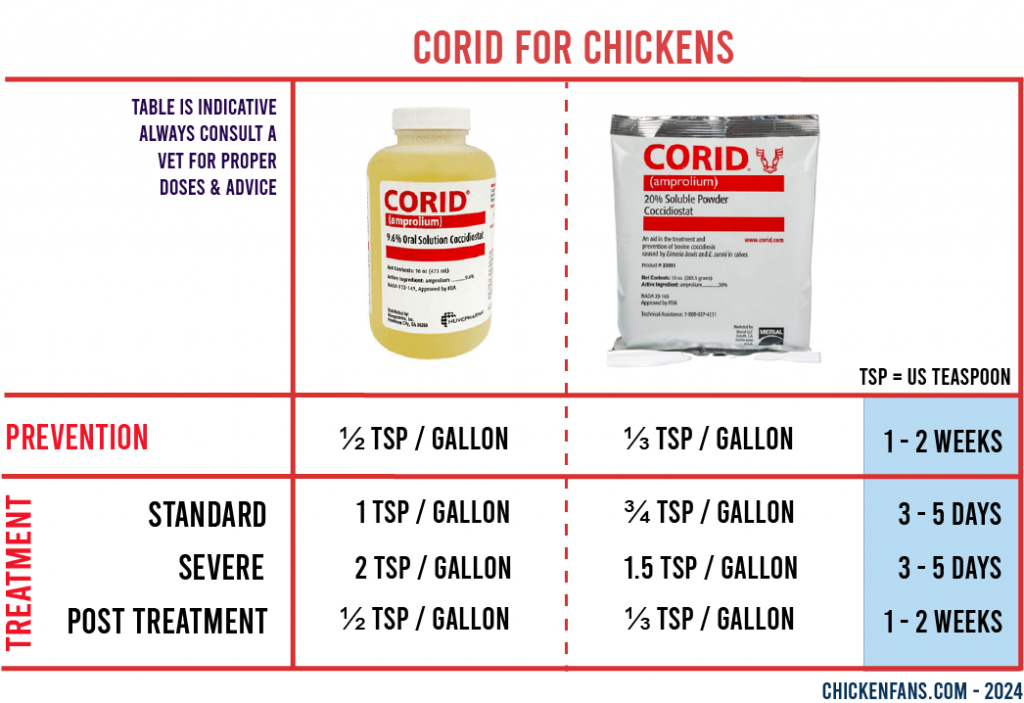
Treatments are sometimes repeated after five days (the prepatent period of the parasite). For severe infections, consider adding vitamin K to the chicken’s diet.
The treatment dosage range above is based on the FDA recommendations for chickens and does not apply to turkeys or other poultry.
How are these doses calculated?
These doses are based on FDA recommendations for chickens:
- 0.012% Amprolium after diagnosis during 3-5 days
- 0.024% in case of severe outbreaks
- 0.006% Amprolium medicated water for an additional 1 to 2 weeks
This FDA Amprolium recommendation is described in §520.100 of the Code of Federal Regulations. Huvepharma, the producer of Corid, has provided the density of its powder.
Water medication is always challenging, as intake varies with the chicken’s water consumption. Typically, a chicken drinks about 500mL of water daily, but this depends on the size of the bird and the outside temperature. Direct dosing (drenching) offers precision but requires an insulin syringe due to the minute doses involved.
Starting treatment
Corid is available over-the-counter in several countries, as it’s not an antibiotic (it’s a coccidiostat).
To diagnose a Coccidiosis outbreak, take your chicken’s droppings to a vet. They’ll easily diagnose coccidiosis microscopically with a fecal flotation test. Once the vet has diagnosed Coccidiosis in one or more of your animals, all other flock members are likely exposed, and all should be treated.
Egg and meat withdrawal
Using Corid does not require an egg-withdrawal period, so that you can enjoy their fresh daily eggs. However, some reports measure traces of Amprolium in the eggs during treatment. A meat withdrawal of 3 days is recommended.
How to Administer Corid?
The administration of Corid is done orally by mixing the medication in the drinking water. The amount of water used is based on their daily water needs.
During treatment, don’t give any other drinking water to your chickens but the medicated water. Ensure they consume the water and replace it after 24 hours. The goal is to prepare a 24-hour supply of the medicated solution by mixing the recommended dosage of Corid with their daily amount of drinking water. Any unused solution must be discarded and replaced with a new batch the following day.
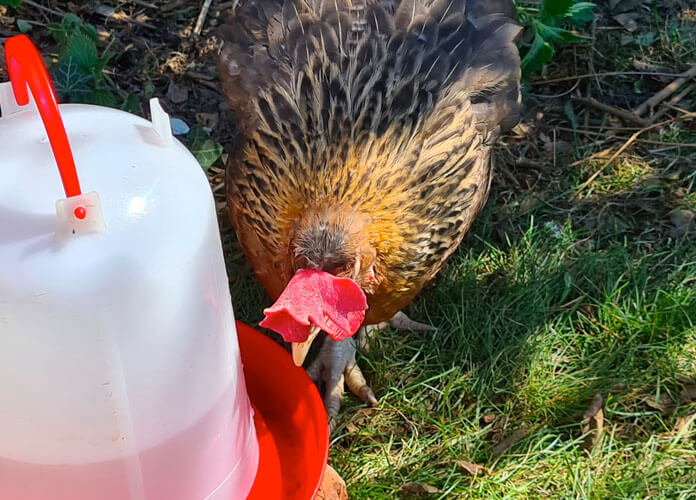
How Effective is Corid?
Corid is known to be highly effective. Its effects can be observed within only a few hours after administration. Research has shown that using amprolium can highly reduce the impact of coccidiosis in poultry. The effectiveness of Corid may vary on the stage of infection, but visible improvements are usually seen within 24 hours after administration. However, two to three days are required to interpret the efficacy of Corid against coccidiosis.
Vitamin K & Corid
Vitamin K can be given to offset the effects of Amprolium and prevent internal bleeding.
Vitamin K exhibits a synergistic effect along with Corid against the coccidia-causing species (Eimeria sp.). It inhibits internal bleeding during coccidiosis and repairs the mucosal linings that have been damaged.
Thus, vitamin K should be provided along with Corid.
Can you Give too Much Corid to Chickens?
Yes, Amprolium has a very small error margin, and excessive use can result in an overdose.
An overdose can result in the following:
- severe spontaneous internal bleeding
- serious neurological problems linked with immunosuppression in chickens
- reduced egg production
- death
The appropriate dosage of Corid should be used for the prevention/treatment of coccidiosis in poultry.
How Does Corid Work?
The active ingredient of Corid is Amprolium, a chemical compound that mimics vitamin B1 (thiamin) and prevents the parasite from synthesizing carbohydrates, so it can’t replicate and dies.
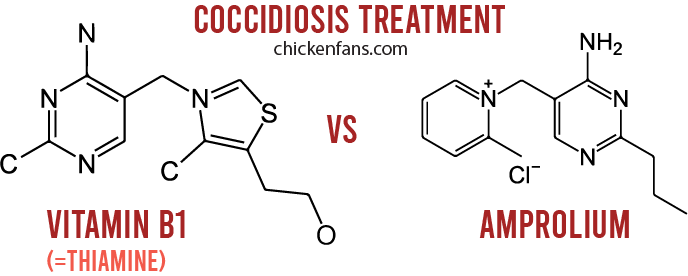
Since Amprolium is so similar to vitamin B1, it inhibits the active transport of real thiamin into the cells.
The coccidia that causes coccidiosis is a small single-celled parasite living in a chicken’s intestines. These cells are 50 times as sensitive to Amprolium as the chicken’s host cells.
Side Effects of Corid
Amprolium is generally well tolerated, but appetite loss and diarrhea are occasional side effects. Neurologic problems (such as difficulty walking) have been documented but are rare. Overall, Corid has few side effects and is considered a safe drug.
However, the margin for error is small, and the doses are sometimes difficult to measure. When you have small chickens, or when they drink too much medicated water, they can get too much Corid. For severe infections, it’s best to add vitamin K to the diet.
When to Avoid Corid?
In some situations, you might reconsider starting a round of Amprolium:
- During the concurrent supplementation of Vitamin B1
- When the birds are infected with fatty liver or other acute disease conditions
- When laying hens are at their peak production cycle
- When chickens are allergic/hypersensitive to Amprolium
Why can’t I Give Corid together with Vitamin B?
When treating with Amprolium, don’t give your chickens extra vitamin B1. It will interfere with the Amprolium that tries to deprive the parasite of its energy sources.
Amprolium, the active ingredient in Corid, acts as an antagonist to thiamin by blocking its receptors. This blockage prevents the parasite causing coccidiosis from taking up thiamin. The parasite cells are 50 times more sensitive to this inhibition than the chicken cells.
Additional Vitamin B1 supplementation can be given after completing the treatment.
How to Store Corid?
When it comes to storing Corid, it is important to ensure that it is kept in a dry and dark location at room temperature (60 to 90°F). The medication should be stored in airtight packaging to preserve its potency and kept out of reach of children for safety reasons.
Amprolium Resistance
Unfortunately, there is some resistance to Amprolium for the treatment of coccidiosis.
Coccidiosis is caused by coccidia, usually Eimeria. This is a genus of apicomplexan parasites with various species.
Depending on the variety, Corid will be either more or less effective:
- More effective against Eimeria tenella and E. acervulina
- Less effective against E. maxima, E. mivati, E. necatrix, or E. brunetti
Most species that affect poultry are from the Eimeria genus, but there are other coccidia affecting birds. If we look beyond Eimeria, Amprolium is usually effective against Isospora sp., but Atoxoplasma coccidia is resistant to treatment.
Corid Alternatives
When Corid is ineffective, other anticoccidial treatments include toltrazuril, ponzuril, and sulfadimethoxine.
While Corid is based on Amprolium, other drugs like Sulmet are antibiotics and are usually only available on prescription by a vet. That’s also why you sometimes see Amprolium in medicated chick starters, available over the counter.
Other Amprolium Brands
As said before, Corid is the brand name of the medicine with the active ingredient amprolium. You can get the medicine over the counter in most countries, albeit under different brand names.
| Active Ingredient | Brand Names |
|---|---|
| Amprolium | Corid, Amprol, Ampromed, Amprosol, Amprosid, Amprovine, Amprolium |
Meanwhile, you can also find some alternative anti-coccidial drugs to amprolium, like toltrazuril and Diclazuril. However, these drugs should be used according to the recommendation of the licensed veterinarian.
Related Questions
You can give Corid to chicks within the 1st week. Moreover, you can use this medication either for prevention or treatment purposes. Adjust the doses accordingly.
No, Corid does not treat worms. Amprolium only fights Eimera, the intestinal parasite causing coccidiosis. It is a single-celled microscopic small protozoan and does not resemble a worm.
Yes, you can eat eggs from chickens treated with Corid. This medication is FDA-approved and needs no egg withdrawal period. However, there have been some reports of traces of Amprolium in the eggs during treatment. That’s why some people toss the eggs away for a few days.
The maximum dose of Amprolium depends on age and weight. It ranges from 25 to 73 mg/kg body weight daily for chickens. For turkeys, it ranges from 14 to 60 mg/kg body weight daily. [EMEA]
References
- EFSA Panel on Additives and Products or Substances used in Animal Feed (FEEDAP), Rychen, G., Aquilina, G., Azimonti, G., Bampidis, V., Bastos, M. D. L., & Gropp, J. (2018). Safety and efficacy of COXAM® (amprolium hydrochloride) for chickens for fattening and chickens reared for laying. EFSA Journal, 16(7), e05338.
- Mathis, G. F., Mcdougald, L. R., & Mcmurray, B. I. R. C. H. (1984). Effectiveness of therapeutic anticoccidial drugs against recently isolated coccidia. Poultry Science, 63(6), 1149-1153.
- Noack, S., Chapman, H.D. & Selzer, P.M. Anticoccidial drugs of the livestock industry. Parasitol Res 118, 2009–2026 (2019). https://doi.org/10.1007/s00436-019-06343-5
- Panel, E.B., 2021. Maximum levels of cross-contamination for 24 antimicrobial active substances in non-target feed. Part 3: Amprolium. EFSA Journal, 19(10), p.e06854.
- Plumb’s Veterinary Drug Handbook 7th Edition Donald C. Plumb, Pharm.D.
- The European Agency for the Evaluation of Medicinal Products Veterinary Medicines and Inspections. MEA/MRL/767/00-FINAL January 2001. Committee for veterinary medicinal products
If you want to read more about chicken health problems, symptoms, and diseases, check out our ‘Health Page‘. You’ll find a ‘Symptom Checker‘, a complete list of ‘Chicken Behavior‘, and an overlook of the most common ‘Chicken Diseases‘. Or go to ‘The Classroom‘ and find a comprehensive list of all Chicken Fans articles.

Dr. Muhammad Farhan is a licensed veterinarian holding a masters degree in Nutritional Sciences. Currently he’s pursuing a PhD in Nutritional Sciences at University of Agriculture, Faisalabad.
